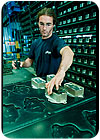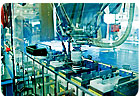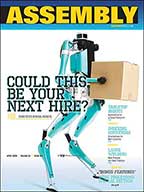
Each cooling unit consists of 10 plates
interspersed with five fins. When they are assembled, a separator plate divides
them from the next stack of plates and fins. Photo by Maurizio Camagna.
Modine Manufacturing Co., a developer of heat transfer cooling systems for vehicles, has placed a high priority on flexibility since its founding in 1916. To maintain this tradition, the company operates several “focused factories,” including one in Pontevico, Italy. The Pontevico facility produces oil coolers for Fiat engines and those of some French and German manufacturers.
Opened in 1999, the Italian facility began automating its production lines in 2003, after Modine successfully introduced automation in a Netherlands plant. One process at the Pontevico plant, in particular, seemed appropriate for automation-the assembly of aluminum plates and fins for engine oil coolers.
Each cooling unit consists of 10 plates interspersed with five fins. When they are assembled, a separator plate divides them from the next stack of plates and fins. As a result, whoever assembles the units must handle 16 different elements of three types and weights. To complicate things further, five different families of coolers are produced in Pontevico.
“We needed robots that could provide reliable high-speed manipulation for this assembly, and we couldn’t find them,” says engineer Gianpaolo Ferrari, safety and environmental coordinator.
Then one day while surfing the Internet for high-speed robots, Ferrari came across a description of FlexPickers made by ABB, and mention of an Italian integrator, CT Pack of Ferrara.

Three IRB 340 FlexPickers are used on the Modine
Pontevico plant’s assembly line, which produces 250,000 units per month. Photo
by Maurizio Camagna.
After meeting with CT Pack to discuss the development of a custom-made line, Modine ordered three IRB 340 FlexPickers in September 2007. After testing the complete line-including peripherals such as a vision system, product handling equipment and automatic assembling magazines-CT Pack installed it in June 2008.
By October 2008, the assembly line was operating at 90 percent of its projected capacity of 250,000 units per month. The assembly line now operates at full capacity, producing 250,000 units per month as it did before automation, but with significantly reduced labor costs.
“Instead of dedicating seven employees per shift, three shifts a day, to the assembly of engine oil cooling units, we now use two employees per shift,” Ferrari says. The other employees have been freed from limited, repetitive operations and reassigned to more demanding, and stimulating, responsibilities.
This installation also was significant because it expanded the FlexPicker’s capabilities, says Stefano Verricelli, ABB’s key account manager for business unit robot products in Italy.
Verricelli notes that the FlexPicker had originally been conceived for the food industry and light consumer goods, not automotive-which is typically the domain of large robots. Also, the FlexPicker was asked to pick up and assemble with high precision rather than simply picking and packing.


